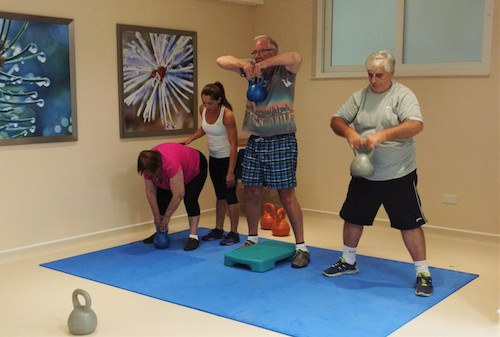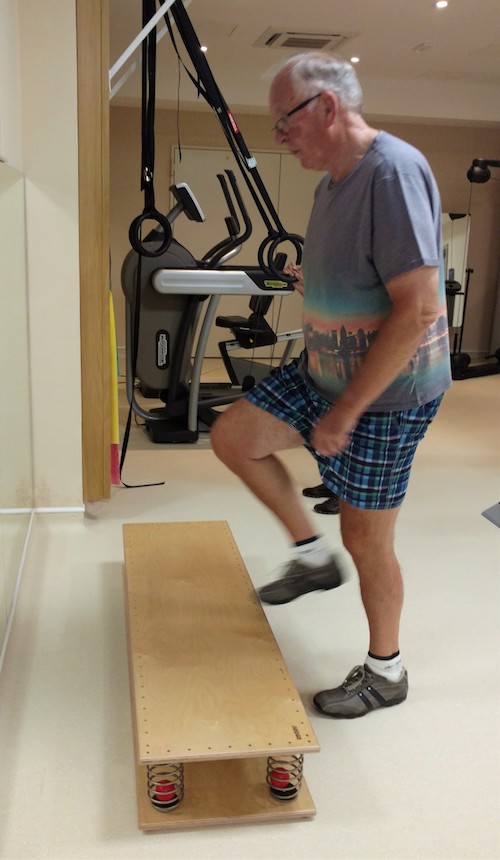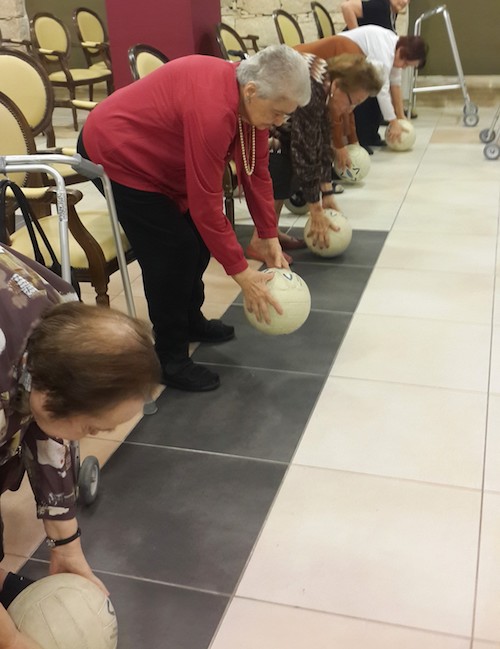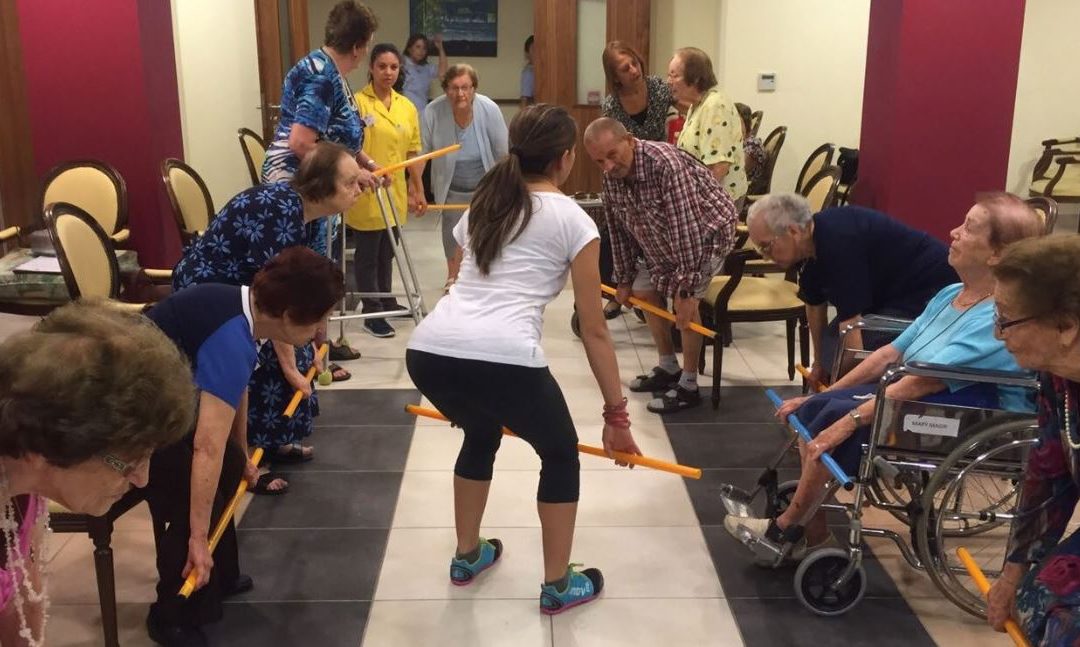Life expectancy has increased drastically, and the number of older persons across the world is expected to more than double over the next four decades to reach a staggering 392 million persons aged 80 years or more by the year 2050 (32).
This increase in life expectancy represents a unique opportunity and challenge for exercise professionals. When it comes to training older adults, we need to move away from the erroneous impression that older adults should only engage in mild-to-moderate physical activity. However, in order to provide a safe yet effective training program, every professional trainer must keep a few things in mind.
The Physiology of Aging
The natural aging process brings about a decline in physical performance that is mostly attributed to a drop in aerobic endurance and muscular strength (25,35,33). The assumption is that loss of muscle size contributes to weakness, so much effort has been dedicated over the years to preventing age-related loss of muscle tissue (10). However, studies have indicated that weakness and muscle size are less tightly related than previously thought, with progression of weakness considerably outpacing the loss of muscle (9,14).

With older adults, movements often need to be modified, and intensity must be closely monitored at all times.
Age-related muscle weakness (dynapenia) can have devastating effects on a person’s ability to perform everyday activities such as climbing stairs, picking up a grandchild, or simply getting out of a chair or bathtub, predisposing older adults to poorer function and greater risk of falls (31).
Training Older Adults
The present body of literature focuses mostly on the use of progressive resistance strength training (1,13,15,18,20,28). However, improving muscle strength alone produces only a trivial change, often non-significant in reducing late-life disability.
Why? Because when the training predominantly focuses on increasing muscle strength, older adults might find difficulty in learning how to transfer this newly found strength to improve their performance of mundane tasks (17).
The most plausible reason for this non-linear transferability is that even though age-related decline in muscle strength is strongly associated with functional decline in older adults (11), the aging process also influences other motor elements such as balance, agility and coordination (27). Therefore, if the exercise program only targets one essential body motor element, the training effect will not necessarily translate into an improvement in everyday function.
On the contrary, functional training approaches such as that seen in CrossFit “train muscles in coordinated, multi-planar movement patterns and incorporate multiple joints, dynamic tasks, and consistent alterations in the base of support” (29), which is more approximate to the way people perform daily tasks (17). Fundamentally, functional training is built on the core principle of training specificity, which means that training in a specific activity is the best way to maximize performance in that specific activity (12,23). This is what the core CrossFit movements are based upon. Squatting, for example, mimics standing from a seated position, and deadlifting mimics picking an object off the floor (7). In other words, the closer the mode of training mimics the desired task or motion, the better the outcome will be. While it might initially seem confusing to talk about specificity in CrossFit, a program that focuses on general physical preparedness (GPP) rather than specific training, “CrossFit’s specificity” is that it uses compound, multi-joint movements that replicate in the gym the way the body must move to accomplish tasks outside the gym.
When using vigorous exercise with older adults, every workout must be specifically designed to accommodate the fitness level and physical limitations of each person.
When using vigorous exercise with older adults, every workout must be specifically designed to accommodate the fitness level and physical limitations of each person while keeping in mind that those things that are core to every younger individual’s fitness are equally important to older adults. As written by CrossFit Founder and CEO Greg Glassman: “Your needs and the Olympic athlete’s differ by degree not kind. Increased power, strength, cardiovascular and respiratory endurance, flexibility, stamina, coordination, agility, balance, and coordination are each important to the world’s best athletes and to our grandparents. The amazing truth is that the very same methods that elicit optimal response in the Olympic or professional athlete will optimize the same response in the elderly” (7).
However, training older adults requires more than simply scaling down the workout of the day. First, moderation of intensity is critical when training older adults, just as it is with deconditioned, sedentary or injured clients. However, one should not rely on the typical signs of intensity—such as sweating and heavy breathing—when working with older adults (21).
Second, one must be aware that the aging process is associated with degeneration of the cartilaginous tissues, leading to tightening of the joints, tendency toward osteoarthritis and loss of tissue elasticity (3), putting older adults at an increased risk of musculoskeletal injury.
Ultimately, when training older adults, the goal should always be that of maintaining independence and improving quality of life. Except in extreme cases involving masters athletes, an older adult’s ability to lift a grocery bag or go face-to-face with small grandchildren is far more important than chasing high performance in the gym, though improved gym performance most certainly relates to improved function outside the gym.
An Eight-Week Study on Retaining Physical Function in Older Adults: The CrossFit Approach
CrossFit is becoming increasingly popular in older populations, but so far no academic studies have delved into the topic of CrossFit and older adults. I am a physiotherapist by profession and was introduced to the world of CrossFit about three years ago. Since then, I have been incorporating some aspects of CrossFit in my work at a geriatric rehabilitation hospital, and after seeing its efficacy, I decided to incorporate CrossFit in my thesis submitted as part of a master’s degree in gerontology and geriatrics.
The primary objective of this study was to test whether CrossFit principles can be safely and effectively used to improve the physical function of older adults, consequently increasing their level of independence in activities of daily living and offering them better quality of life. The second aim was to investigate the perception older adults have of this training program.
Method
The study population consisted of 20 older adults (19 females and 1 male) who were voluntarily recruited from two residential-age care homes in Malta. The ages varied between 75 and 91 years old, with a mean age of 84. The intervention consisted of 16 CrossFit-based exercise classes, with two sessions taking place every week for eight weeks and each session lasting between 45 minutes and an hour.

All sessions included a dynamic warm-up, skill/strength work, a conditioning component and stretching.
The participants’ level of functional fitness was measured before and at the end of the intervention using the Senior Fitness Test, which is composed of a battery of test items specifically designed to assess the four physical parameters identified as being the relevant components of functional fitness in older adults (24): muscular strength, aerobic endurance, flexibility, and agility and dynamic balance. After completing the exercise program, participants were asked to take part in a focus-group discussion to express their perceptions and personal experiences of the exercise program.
CrossFit aims to optimize physical competence in each of 10 fitness domains: cardiovascular and respiratory endurance, stamina, strength, flexibility, power, speed, coordination, agility, balance, and accuracy (7). While all are valuable, the domains that are paramount for older adults are balance, flexibility, strength and aerobic fitness (2), and this intervention focused on these elements.
A typical session consisted of four components:
Dynamic warm-up—Warm-up featured a set of exercises intended to elevate the heart rate and increase the body temperature. The warm-up lasted 10 to 15 minutes and consisted of aerobic exercises, functional movements, joint-mobility work and stretches that complemented the movements in the workout of the day.
Skill/strength work—This part lasted around 10 minutes. On some days the aim was to master a specific skill that would later be used during the workout of the day, while on other days the focus was on strength training.

Workout of the day—This component lasted between 15 to 30 minutes depending on the intensity and consisted of a combination of exercises such as squats, lunges, push presses, deadlifts, ground-to-overheads and step-ups. Every participant was advised to work with the weight and intensity he or she felt comfortable with, and all exercises were modified to the needs of the individual. As stated by Powell (21), “relative intensity” is most important when training older adults. The workouts were carried out individually or in a team depending on the session.
Cool-down and stretching—The last few minutes were always dedicated to cool-down and a series of stretches for the major muscle groups.
The exercise sessions were designed to be progressive in nature, and the first few focused on mastering four of CrossFit’s nine fundamental movements: squat, front squat, overhead squat and press. We also introduced the deadlift, sumo deadlift high pull and medicine-ball clean later. The push press and push jerk complete the list (34) but were not included in this program because they require a higher level of skill. Although these lifts are beneficial, the researcher chose to focus on those functional movements that are most relevant in the geriatric scenario. The nine foundational CrossFit movements are important because capacity and sound mechanics in these movements constitute the essence of physical competence in three-dimensional space, and they translate readily to all other movements (34). As participants started to master these movements, the difficulty level was increased by utilizing more complex exercises that involved multiple movements (e.g., ground to overhead) and additional balance components (e.g., catching a ball from various heights).
Results
All the participants led a sedentary lifestyle and started the intervention at rather poor fitness levels. Some used walking aids, and others could not even rise from a chair without having to ask for assistance. For this reason, all the exercises had to be highly scaled. However, following eight weeks of training, all participants still achieved a satisfactory improvement in both upper- and lower-body strength as measured by the chair-stand test (45.8 percent average improvement) and the arm-curl test (39.2 percent average improvement). This supports the idea that although high training intensities appear to be necessary to achieve muscle hypertrophy, training at lower intensities is sufficient to initiate neuromuscular improvements (30).
Most participants also improved significantly in lower-body flexibility (51.6 percent average improvement): “I enjoy sitting on my couch watching TV, but before when I used to drop something like the remote control, I had to get up and struggle to pick it up. I love that now I can just bend over and reach for it” (78-year-old female).

The eight-week program was progressive in nature, and testing at completion revealed marked increases in participants’ strength and conditioning.
However, at the end of the intervention a few participants still struggled with movements that required reaching down for their toes: “Before it was very difficult to bend and reach for my toes especially to put on tights; I never used to manage. Although I still cannot do it, I feel I have improved, and I want to continue carrying out these exercises until I manage to put on my tights” (90-year-old female).
On the other hand, the extent of improvement in upper-body flexibility as measured by the back-scratch test (8 percent average improvement) was much smaller than that observed for lower-body flexibility, and for most participants it was not sufficient to bring about an improvement in everyday function. These results are in line with the findings reported by Misner and colleagues (19), who studied the long-term (five years) effects of exercise on shoulder and hip range of motion and reported only a trivial improvement in shoulder range of motion as opposed to hip range of motion.
The participants claimed that since they started taking part in this CrossFit-based exercise program, they felt increasingly fit and energetic.
There was also a marked improvement in aerobic endurance (21 percent average improvement) as measured by the two-minute step test, and the participants claimed that since they started taking part in this CrossFit-based exercise program, they felt increasingly fit and energetic. More importantly, this increase in exercise tolerance enabled them to complete activities they were not able to do before, such as going to the market or simply managing a flight of stairs.
“I enjoy going to the local market and whilst before I had to stop and rest a few times on the way, now I can keep on going,” an 81-year-old female stated.
According to their initial scores of agility and dynamic balance, all participants were at an increased risk of falling. At the end of the intervention, this study found an average improvement of 15 percent in the participants’ agility and dynamic balance as measured by the timed up-and-go test. However, when comparing the scores achieved by the participants to normative scores based on a validity study of community-dwelling older adults, this improvement was not enough to substantially abridge their risk of falling. Having said that, the participants still reported a decrease in fear of falling and an improvement in their everyday level of function. Most of this improvement can be attributed to an increase in self-confidence, as participants believed more in their abilities.

Moreover, the participants explained how this increase in agility and balance led to a boost in their self-image and self-esteem. For example, an 84-year-old lady shared that the previous day they had an outing, and while the bus driver usually had to bring her a step to go up on the bus, this time she managed to go up and down without the need for the step. Although it might not sound like much, to her it meant regaining some of her lost independence.
Activity avoidance due to fear of falling is common in older adults—even in those without a history of falls (37). Older people who are afraid of falling and consequently avoid activities enter a debilitating spiral of loss of confidence, restriction of physical activities and social participation, physical frailty, falls, and loss of independence (5,38).
“The major positive impact these exercises had on my life is the fact that now I can manage to go up and down a few steps. Before I did not manage and I used to avoid them completely because I was too scared of falling. Now I feel much more confident and I can even manage certain movements (she said while bracing herself) that I could not manage before such as crossing my hands over my body,” said a 78-year-old female.

Over and above the physical improvements, CrossFit gave participants the opportunity to build new friendships and widen their social circle. While exercise served as a communal topic in conversation, it made them feel more included and more confident in joining social events. With older adults in long-term care being inactive and alone up to 65 per cent of their time (6), this study suggests that a CrossFit-based group-exercise program can be an effective method to reduce loneliness in older adults living in long-term care. Evidence does in fact show that social-network involvement is associated with health and well-being across the lifespan (16) because members of a social network can facilitate an older adult’s adaptation to life-changing events (26).
Throughout the course of the study, there were no reports of any injuries or negative repercussions. Thus, this study supports that CrossFit is safe and well tolerated in healthy older adults even in the eighth and ninth decades of life. It can prove challenging to provide the necessary individual attention and meet the needs of the individual while tending to a large class, so I suggest that initially older adults—especially those starting from sedentary lifestyles—should start training individually or in small groups until they can master the basic movements and reach a fitness level that allows them to join a class.

Conclusion
Overall, the CrossFit-based exercise program implemented by this study was a success, suggesting that two CrossFit-based exercise classes per week have the ability to enhance the level of physical function in older adults, including those in their eighth and ninth decades of life and those living in long-term residential care. Older adults perceive CrossFit as a fun method of training and recognize that its functional nature and holistic approach can help them improve their ability to carry out everyday tasks and subsequently retain their independence.
Finally, implementing a CrossFit-based exercise program for older adults is feasible even with restricted financial resources because every open space can be adapted and used for training.
References
- Baker MK, Atlantis E, and Fiatarone Singh MA. Multi-modal exercise programs for older adults. Age and Ageing 36: 375- 381, 2007.
- Baker J, and Boudreau Convoner M. Exercise for successful ageing. 2010. Last accessed Sept. 7, 2016.
- Besdine R. Physical changes with aging. Merck Manual, 2013.
- Cej M. Older, wiser, fitter. The CrossFit Journal: 1-7, 2013.
- Deshpande N, Metter EJ, and Lauretani F et al. Activity restriction induced by fear of falling and objective and subjective measures of physical function: A prospective cohort study. Journal of the American Geriatric Society 56: 615-620, 2008.
- Foster A, Lambey R, and Hardy J et al. Rehabilitation for older people in long-term care. Cochrane Database System Review CD004294: 2009.
- Glassman G. Foundations. The CrossFit Journal: 1-8, 2002.
- Glassman G. Understanding CrossFit. The CrossFit Journal 56: 1-2, 2007.
- Goodpaster BH, Park SW and Harris TB et al. The loss of skeletal muscle strength, mass, and quality in older adults: The health, ageing and body composition study. Journals of Gerontology: Medical Sciences 61: 1059-1064, 2006.
- Greenlund LJ and Nair KS. Sarcopenia–consequences, mechanisms, and potential therapies. Journals of Gerontology: Medical Sciences 124: 287-299, 2003.
- Hairi NN, Cumming RG, Naganathan V, Handelsman DJ, Le Couteur DG and Creasey H et al. Loss of muscle strength, mass (sarcopenia), and quality (specific force) and its relationship with functional limitation and physical disability: The Concord Health and Ageing in Men project. Journal of the American Geriatric Society 58: 2055-2062, 2010.
- Hawley J. Specificity of training adaptation: Time for a rethink? Journal of Physiology 586: 1-2, 2008.
- Holviala J, Kraemer WJ, Sillanpaa E, Karppinen H, Avela J and Kauhanen A et al. Effects of strength, endurance and combined training on muscle strength, walking speed and dynamic balance in ageing men. European Journal of Applied Physiology 112: 1335-1347, 2012.
- Hughes VA, Frontera WR and Wood M et al. Longitudinal muscle strength changes in older adults: Influence of muscle mass, physical activity, and health. Journals of Gerontology Series A: Biological Sciences and Medical Sciences 56: B209-B217, 2001.
- Karavirta L, Tulppo MP, Laaksonen DE, Nyman K, Laukkanen RT, and Kinnunen H et al. Heart rate dynamics after combined endurance and strength training in older men. Medicine and Science in Sports and Exercise 41: 1436-1443, 2009.
- Krause N. Social relationships in later life. In Handbook of Ageing and the Social Sciences Vol. 6. Binstock R and George L, eds. San Diego, Calif.: Academic Press, 2006. pp. 181-200.
- Liu C, Shiroy DM, Jones LH and Clark DO. Systematic review of functional training on muscle strength, physical functioning, and activities of daily living on older adults. European Group for Research Into Elderly and Physical Activity 11: 95-106, 2014.
- Mian OS, Baltzopoulos V, Minetti AE and Narici MV. The impact of physical training on locomotor function in older people. Sports Medicine 37: 683-701, 2007.
- Misner JE, Massey BH, Bemben M, Going S, and Patrick J. Long-term effects of exercise on the range of motion of ageing women. Journal of Orthopaedic and Sports Physical Therapy 16(1): 37-42, 1992.
- Orr R, Raymond J and Fiatarone Singh MA. Effficacy of progressive resistance training on balance performance in older adults: A systematic review of randomized controlled trials. Sports Medicine 38: 317-343, 2008.
- Powell J. Training Silvers. The CrossFit Journal: 1-8, 2010.
- Reaburn P. Nutrition and Performance in Masters Athletes. Boca Raton, Fla.: CRC Press, 2014.
- Reilly T, Morris T and Whyte G. The specificity of training prescription and physiological assessment: A review. Journal of Sports Sciences 27: 575-589, 2009.
- Rikli R and Jones, J. Senior Fitness Test Manual: Second Edition. Champaign, Ill.: Human Kinetics, 2013.
- Robergs RA and Roberts SO. Exercise and ageing. In Exercise Physiology: Exercise, Performance, and Clinical Applications. St. Louis, Mo.: Mosby, 1997. pp. 578-599.
- Rook K. Social networks in later life: Weighing positive and negative effects on health and well-being. Current Directions in Psychological Science 24(1): 45-51, 2015.
- Seidler RD, Bernard JA, Burutolu TB, Fling BW, Gordon MT and Gwin JT et al. Motor control and aging: Links to age-related brain structural, functional, and biochemical effects. Elsevier Journals: Neuroscience & Behavioural Reviews 34: 721-733, 2010.
- Sillanpaa E, Laaksonen DE, Hakkinen A, Karavirta L, Jensen B, Kraemer WJ. Body composition, fitness and metabolic health during strength and endurance training and their combination in middle aged and older women. European Journal of Applied Physiology 106: 285-296, 2009.
- Sipe C and Ritchie D. The significant 7 principles of functional training for mature adults. IDEA Fitness Journal 9: 42-49, 2012.
- Steib S, Schoene D and Pfeifer K. Dose-response relationship of resistance training in older adults: A meta-analysis. Medicine & Science in Sports & Exercise: 902-914, 2010.
- Stenholm D, Tiainen K, Rantanen T, Sainio P, Heliovaara M and Impivaara O et al. Long-term determinants of muscle strength decline: Prospective evidence from the 22-year Mini-Finland follow-up survey. Journal of the American Geriatric Society 60: 77-85, 2012.
- United Nations. World Population Ageing. New York, N.Y.: Department of Economic and Social Affairs Population Division, 2013.
- Vandervoort A. Ageing of the human neuromuscular system. Muscle and Nerve 25: 17-25, 2002.
- Widman T. A CrossFit startup guide. The CrossFit Journal: 1-7, 2009.
- Wilmore JH and Costill DL. Physiology of Sport and Exercise: 3rd Edition. Champaign, Ill.: Human Kinetics, 2005.
- Wilson TM and Tanaka H. Meta-analysis of the age-associated decline in maximal aerobic capacity in men: Relation to training status. American Journal of Physiology—Heart and Circulatory Physiology 278: H829-H834, 2000.
- Yardley L and Smith H. A prospective study of the relationship between feared consequences of falling and avoidance of activity in community-living older people. Gerontologist 42: 17-23, 2002.
- Zijlstra GA, Van Haastregt JC, Ambergen T, Van Rossum E, Van Eijk JM, and Tennstedt SL, et al. Effects of a multicomponent cognitive behavioral group intervention on fear of falling and activity avoidance in community-dwelling older adults: Results of a randomised controlled trial. Journal of the American Geriatrics Society 57: 202-2028, 2009.

